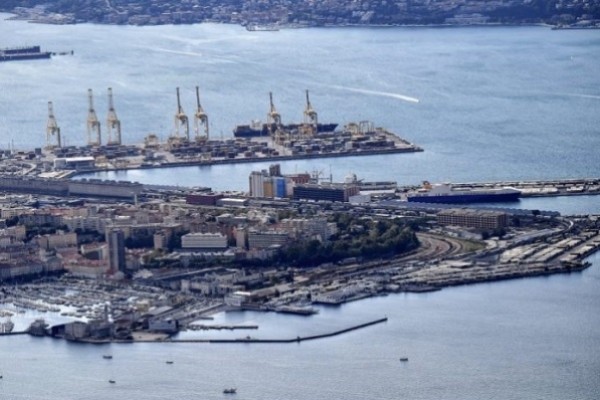| Trieste port will compete directly for cargo with Piraeus | |

| Author: SEEbiz / JOC.com |
| 25th March 2019 |
| LONDON - Italy is moving closer to striking an agreement with China that would improve the containerized rail reach of Trieste, heating up competition for Central and North European markets between the Adriatic port and Beijing-backed Cosco Shipping’s own gateway in Piraeus, Greece. |
|
Italy signed up to Beijing’s Belt and Road initiative, a move aimed at securing vitally needed investment to improve rail connections with the key Adriatic-Baltic corridor and Mediterranean corridors. If China’s investment in Piraeus is a guide, the deal will grow ocean container volume, but it would also attract shippers that normally ship through Piraeus to central, eastern, and southern Europe, as the northern Adriatic port of Trieste positions itself as a southern European gateway for China. That would raise questions about the future of Piraeus, China’s current Mediterranean transshipment hub. Since 2016, Beijing has invested heavily in Piraeus via Cosco Shipping Ports. The China port operator in 2008 signed a 35-year deal to operate two container terminals and in 2016 acquired 67 percent of the Piraeus Port Authority for $420 million to become the primary operator. It has been a lucrative investment that has seen Piraeus climbing up the European port rankings from outside the top 15 in 2007 to sixth-busiest in Europe in 2018 when cargo volume spiked 21 percent year over year to 4.9 million TEU. But even without an Italy-China deal in place, Trieste has been steadily building its container throughput. The port handled 1.4 million TEU in 2018, an increase of almost 8 percent compared with the previous year. The EU Commission has adopted Italy’s National Operational Program (NOP) on Infrastructure and Networks for the period 2014-2020 by making $2 billion available for investing in railway and port infrastructure, and intelligent transport systems, according to a statement by the Italian Ministry of Infrastructure and Transport. “These resources are added to the important national allocations which are specifically devoted to implementing the railway links of the south of Italy, paying a special attention to the ports and airports, which are currently poorly connected or isolated from the national infrastructures network, or last mile connections,” the statement said. Some of that investment in rail freight and logistics will be in the Trieste Port Authority's 2017-2019 Operating Plan that includes subsidized and non-repayable loans from the European Commission to upgrade rail connections at the port. The port authority estimates that the number of freight trains to and from terminals last year increased by 12 percent to 10,000. Zeno D’Agostino, president of the Port System Authority of the Eastern Adriatic Sea, a public body controlling port operations and commercial and industrial activities at Trieste, said he expected a further 10 percent increase in the number of trains handled by the port this year. Trieste is at the nexus of the key Adriatic-Baltic rail corridor that extends north to Gdansk in Poland, and its geographical position gives the port an edge over Piraeus, which is much farther south. Via the Adriatic-Baltic corridor and its rail tributaries, Trieste has links with Austria, Germany, the Czech Republic, Belgium, Hungary, Luxembourg, and Slovakia, with several routes served by direct trains. Transportation consultant Andre Wheeler said Trieste was well positioned for trade with China, and its advantages include having 60 feet of water depth, the same as Piraeus, that can accommodate mega-ships, and legal status as an international free port. Should Trieste become part of the Belt and Road program, however, it will compete for cargo directly with Piraeus. Rising container volume through the Mediterranean has placed Piraeus and the Spanish port of Valencia on course to leapfrog the German port of Bremerhaven as Europe’s fourth-busiest container port. Valencia recorded a 5.3 percent increase in volume in 2018 to 5.1 million TEU, while Bremerhaven’s throughput declined 1.3 percent to 5.4 million TEU, according to port statistics. Cosco Shipping Ports owns 49 percent of the port of Valencia’s parent company, Noatum Port Holdings. “It is likely that a south European port will enter the top 4 in 2019 or 2020 at the latest,” Theo Notteboom, a professor in port and maritime economics and management at Ghent University in Belgium, said in a top 15 Europe ports report published on LinkedIn. Another port that could feel the effects of Trieste’s Belt and Road status is its neighbor in the North Adriatic, the Slovenian port of Koper. Just a few miles away from Trieste across the Italy-Slovenia border, the port competes for ocean container volume from China that is also transported via the rail and road network into southern and eastern Europe. Koper grew its throughput 8 percent last year to just short of 1 million TEU, and the port’s modal split is 6 percent rail and 40 percent road. A total of 23,084 trains arrived and departed the port in 2018, with 326,000 trucks entering the port. |
 |
|
| 23rd November 2024 | |
| China has good news for Croatian citizens | |
 |
|
| 7th November 2024 | |
| Pelagos net farm products presented at the Shanghai fai | |